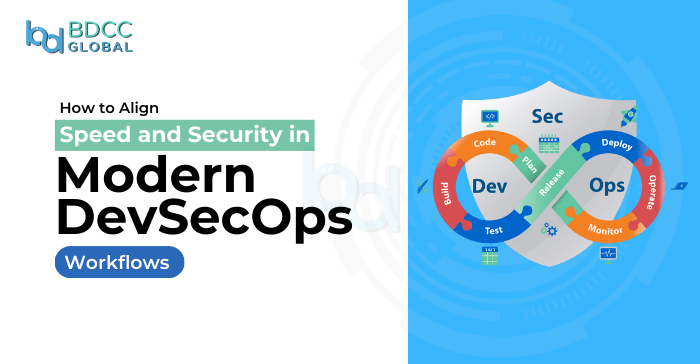
In the world of modern software delivery, speed is a given. But speed without security? That’s a recipe for disaster. DevSecOps has emerged as the answer—bringing development, security, and operations into a shared framework. Still, the reality on the ground is often messy.
Developers push for rapid releases. Security teams push back, prioritizing risk management. This constant tug-of-war raises a critical question: How do you balance agility and security in DevSecOps without compromising either?
This blog walks you through four practical steps to create secure DevOps workflows that don’t sacrifice speed.
Agility vs Security: The Core DevSecOps Dilemma
At its heart, DevSecOps aims to break down silos. But that doesn’t automatically eliminate friction. The core challenge lies in the DevSecOps agility vs security paradox.
Continuous integration and deployment (CI/CD) thrives on rapid iteration. Meanwhile, traditional security practices focus on careful review, layered approvals, and compliance checks. These priorities often clash.
Delays in security reviews can frustrate developers. Workarounds may be used to bypass rigid controls. And when a breach happens, finger-pointing begins. The issue isn’t DevSecOps itself—it’s how teams implement it without aligning on shared goals.
The solution lies in building workflows that integrate security into development from the start, without creating drag. And it all begins with shifting left.
Also know how AI Is reshaping DevSecOps governance.
Step 1: Shift Left Without Slowing Down
Shifting security left means identifying and addressing vulnerabilities as early as possible in the software development lifecycle. But it must be done without slowing the team down.
Instead of treating security as a final gate, integrate it into the development and build phases. This means embedding static analysis, secrets detection, and code linting tools directly into your CI pipeline. When developers receive feedback during commit or merge time, they can fix issues faster, often within minutes.
However, tools alone won’t drive change. Culture is key. Developers should be empowered—not burdened—with security ownership. When teams adopt a security-first mindset, vulnerabilities are seen as part of the development workflow, not a separate responsibility. Security conversations should be part of daily standups and sprint reviews, not just quarterly audits.
In short, security should become just another definition of “done.”
Step 2: Use Policy-as-Code to Set Guardrails, Not Roadblocks
Speed doesn’t have to mean recklessness. By defining security policies as code, teams can apply consistent, automated rules across infrastructure, environments, and workflows—without creating bottlenecks.
With Policy-as-Code, security rules are version-controlled, tested, and enforced automatically. This allows teams to prevent insecure configurations early, such as denying public S3 buckets or enforcing encrypted storage. Tools like Open Policy Agent (OPA) and HashiCorp Sentinel make this achievable at scale.
The advantage? Developers work within clear, codified guardrails. If a configuration fails, they receive instant, actionable feedback. This eliminates the need for manual approvals or delayed reviews.
Crucially, policies should enable secure defaults and offer guidance. Instead of throwing errors, provide context and suggestions. If a container image is non-compliant, suggest an approved alternative. This reduces friction and builds trust.
Step 3: Make Threat Modeling and Feedback Loops Continuous
Threat modeling often gets treated like a one-time task—done at the start of a project, then forgotten. In a fast-paced DevSecOps environment, that’s not enough.
Security threats evolve with every sprint. New APIs, third-party integrations, and configuration changes can all introduce new risks. That’s why continuous threat modeling should become a core part of your agile process.
Rather than running lengthy workshops, adopt a lightweight, iterative approach. During sprint planning or backlog grooming, ask simple questions like:
What could go wrong?
What would an attacker target here?
What’s our fallback if this fails?
These quick, team-based discussions surface risks early—before they hit production.
Once identified, security issues must flow into familiar tools. Devs shouldn’t have to switch platforms or hunt for context. Integrate alerts into Jira, GitHub, or Slack. Make remediation as frictionless as possible.
Effective feedback loops ensure that security findings aren’t just identified—they’re resolved. And patterns can be tracked to drive long-term improvements.
Step 4: Monitor and Optimize with Smart Security Metrics
What gets measured gets improved. But traditional DevOps metrics alone won’t reveal your security posture. To truly balance agility and security in DevSecOps, you need a blend of velocity and vulnerability insights.
Security KPIs worth tracking include:
- Mean Time to Remediate (MTTR) vulnerabilities
- Percentage of issues caught pre-production
- Coverage of policy-as-code enforcement
- False positive rates from scanning tools
Combine these with DORA metrics—deployment frequency, lead time for changes—to get a holistic view of how security impacts delivery.
These insights help teams identify real trade-offs. For instance, if a new SAST tool reduces MTTR by 40% but increases pipeline runtime by 5 minutes, the trade might be worth it. But if a policy adds friction with no measurable risk reduction, it’s time to reassess.
Data drives better conversations between security and development. Decisions are no longer emotional—they’re evidence-based.
Conclusion: Secure at Speed Is Possible
Security and agility are not opposing goals. When done right, DevSecOps aligns both without compromise. But this doesn’t happen by default—it takes intentional process design, cultural alignment, and the right tools.
To recap, here are the four steps that help create secure DevOps workflows that scale:
- Shift security left and automate for speed
- Codify policies to create guardrails, not gates
- Make threat modeling continuous with actionable feedback loops
- Use metrics to optimize and drive informed decisions
Modern teams can’t afford to treat security as a blocker or an afterthought. By embedding it deeply into every stage of the pipeline, organizations gain both speed and resilience.
Balancing agility and security in DevSecOps isn’t just a best practice—it’s a competitive edge.
Ready to Build a DevSecOps Culture That Works?
Whether you’re just starting out or scaling a mature DevSecOps model, our experts help teams design workflows that don’t compromise on speed or safety.
Let’s connect and explore how to implement DevSecOps best practices tailored to your business.
BDCC
Latest posts by BDCC (see all)
- Four Steps to Balance Agility and Security in DevSecOps - April 22, 2025
- Enhancing Security Posture with Azure’s AI-Driven Threat Detection - April 15, 2025
- Why Golang is Becoming the Go-To Language for DevOps Engineers - April 11, 2025

